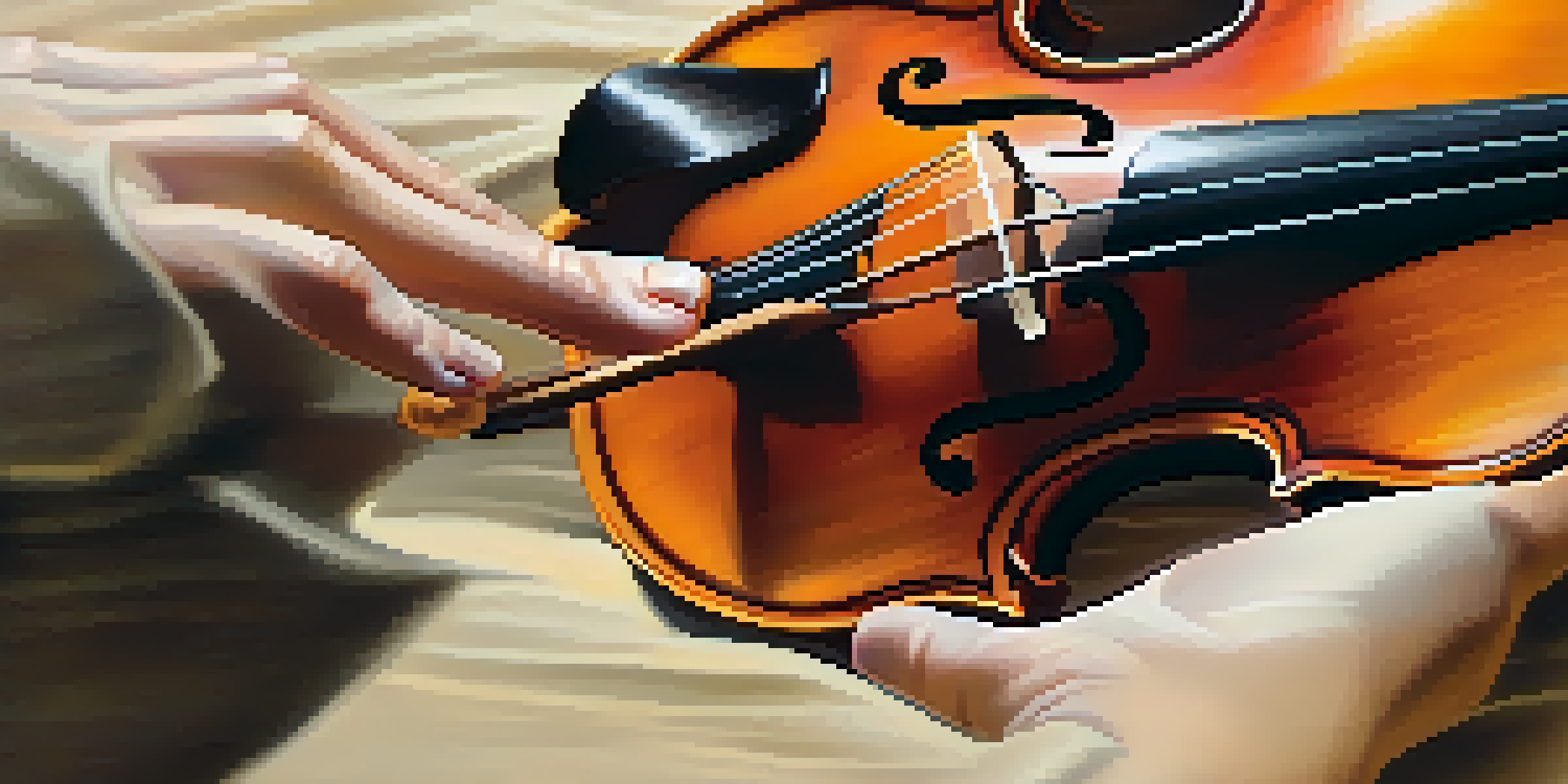Effective Vibrato Techniques for String Instruments

Understanding Vibrato: What It Is and Why It Matters
Vibrato is a technique used by string players to add expression and depth to their music. Essentially, it involves a slight oscillation of pitch, which enriches the sound and makes it more emotive. Just like a singer might vary their pitch to convey feeling, string players use vibrato to create a more dynamic performance.
Vibrato is the soul of music, a way to express what words cannot.
When executed properly, vibrato can transform a simple note into something truly captivating. It helps to sustain the note while also adding warmth, making it a fundamental tool for any string player. Understanding the role of vibrato in music is crucial for musicians looking to elevate their playing.
Incorporating vibrato into your practice not only enhances your musicality but also engages your audience. It's one of those elements that can take your performance from good to unforgettable, so it's worth investing time and effort into mastering it.
The Basic Mechanics of Vibrato Technique
At its core, vibrato involves the movement of the left hand to create a variation in pitch. This can be achieved by rocking the hand back and forth or by moving the finger in a circular motion. Each method has its own sound and character, allowing players to choose what best suits their style.

For beginners, focusing on finger stability while practicing vibrato is essential. You might find it helpful to start with small, controlled movements before gradually increasing the range and speed. Think of it like learning to ride a bike; you have to find your balance before you can speed down the road.
Vibrato Enhances Musical Expression
Vibrato adds depth and emotion to music, transforming simple notes into captivating performances.
As you become more comfortable, experiment with different speeds and widths of vibrato. This exploration will help you discover what feels natural and what enhances the music you are playing. Remember, vibrato is a personal expression, so find a style that resonates with you.
Different Types of Vibrato: Finding Your Style
There are several types of vibrato, each adding its unique flavor to your sound. The most common types are arm vibrato, wrist vibrato, and finger vibrato. Arm vibrato involves using the whole arm to create motion, giving a broader and deeper effect, while wrist vibrato focuses on smaller, more precise movements.
Music is the shorthand of emotion.
Finger vibrato, on the other hand, is primarily about the motion of the fingers themselves. This technique can be particularly effective for fast passages where a subtle vibrato is desired. Think of these techniques as different spices in your musical kitchen—each adds a different taste to your overall dish.
Experimenting with these various types will not only enhance your vibrato but also develop your overall playing technique. As with any skill, practice is key, and each type of vibrato can be honed to suit your musical preferences.
Practicing Vibrato: Tips for Consistency
Consistency is crucial when developing your vibrato technique. One effective way to practice is to dedicate specific time during your warm-up to focus solely on vibrato exercises. This could involve playing long notes and applying vibrato at varying speeds, which helps build muscle memory.
Utilizing a metronome can also aid in maintaining a steady rhythm while practicing. Start slow and gradually increase the tempo, ensuring that your vibrato remains controlled and expressive. This slow progression is akin to building a solid foundation for a house; the stronger the base, the better the outcome.
Practice Makes Perfect Vibrato
Consistent practice and specific exercises are essential for developing a controlled and expressive vibrato technique.
Additionally, recording yourself while practicing can provide valuable insights. Listening back allows you to hear your vibrato in action, helping identify areas for improvement. This reflective approach can be incredibly beneficial for both your technique and overall musicianship.
Integrating Vibrato into Musical Contexts
Once you’ve mastered the mechanics of vibrato, the next step is to explore how to integrate it into your playing. Different pieces of music will call for varying levels of vibrato intensity, so being adaptable is key. For example, a romantic piece may benefit from a wider, more expressive vibrato, while a faster, technical piece might require a subtler approach.
Listening to professional recordings can provide valuable examples of how vibrato is used in different contexts. Pay attention to how artists employ vibrato to enhance the emotional content of their performances. This analysis can inspire you and offer practical insights into your own playing.
Ultimately, the goal is to use vibrato as a tool to convey the music's emotional intent. Think of it as coloring in a black-and-white drawing; the vibrato adds vibrancy and life to your performance, making it more engaging for your audience.
Common Vibrato Mistakes and How to Avoid Them
Even seasoned musicians can fall into common vibrato pitfalls. One of the most frequent mistakes is overusing vibrato, which can make the music feel cluttered or overwhelming. It's essential to find the right balance and use vibrato judiciously, ensuring it complements rather than overshadows the melody.
Another mistake is having an inconsistent vibrato speed or width. This can distract the listener and detract from the overall performance. To avoid this, focus on maintaining a steady tempo during practice and deliberately work on achieving a uniform vibrato across different notes.
Different Vibrato Types to Explore
Experimenting with various vibrato techniques allows musicians to find their unique sound and enhance their overall playing.
Lastly, be wary of tension in your hand and arm while playing. Excessive tension can hinder your vibrato's effectiveness and lead to fatigue. Regular relaxation exercises and mindful playing can help ensure that your vibrato remains fluid and expressive.
Conclusion: The Journey to Vibrato Mastery
Mastering vibrato is a journey that requires patience, practice, and self-reflection. As you work through the various techniques and styles, remember that every musician's vibrato is unique. Embrace your individuality and let it shine through in your playing.
Incorporating vibrato into your performance not only enhances your sound but also deepens your connection with the music. It’s about telling a story, and vibrato is one of the most powerful tools you have to convey that narrative.

So, keep experimenting, keep practicing, and most importantly, enjoy the process. Over time, you'll find that vibrato becomes a natural extension of your musical expression, enriching your performances and captivating your audience.